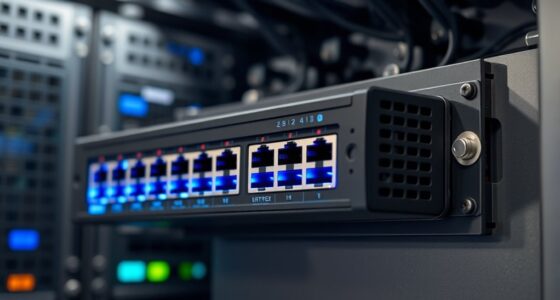If you’re searching for the best managed gigabit switches for small businesses in 2025, I can help you find top options like the TEG-3102WS, STEAMEMO 26-Port, NETGEAR GS308E, and Cisco CBS220-24T. These models offer high speed, easy management, and scalability to support future growth. From PoE capabilities to durable build quality, I’ll guide you through each choice. Keep going, and you’ll discover the perfect switch to power your network confidently.
Key Takeaways
- Select switches with multi-gig ports (2.5Gbps and 10Gbps) for future-proof high-speed network performance.
- Prioritize managed switches with user-friendly web interfaces for easy VLAN, QoS, and security configuration.
- Consider PoE support with sufficient power budgets for IP cameras, VoIP, and wireless access points.
- Opt for durable, energy-efficient models with warranties suitable for small business environments.
- Balance scalability options like SFP+ uplinks and port count to accommodate future network expansion needs.
TRENDnet 10-Port Multi-Gig Web Smart Switch (TEG-3102WS)

If you’re a small business owner looking to upgrade your network with high-speed, reliable connections, the TRENDnet TEG-3102WS is an excellent choice. This 10-port multi-gig web smart switch offers eight 2.5GBASE-T ports and two 10G SFP+ slots, supporting speeds up to 2.5Gbps and 10Gbps for uplinks. Its durable metal housing and energy-efficient design guarantee longevity and quiet operation. The switch features a web-based GUI for easy management of VLANs, QoS, and link aggregation, with no complex configuration needed. It’s perfect for SMBs seeking flexible, future-proof connectivity in a compact, cost-effective package.
Best For: small to medium-sized businesses seeking affordable, high-speed network upgrades with easy management and future-proof uplink options.
Pros:
- Supports multi-gigabit speeds up to 2.5Gbps on copper ports and 10Gbps on SFP+ uplinks.
- Web-based GUI makes configuration straightforward for basic network management.
- Durable metal housing with energy-efficient and quiet operation suitable for various environments.
Cons:
- Limited VLAN configuration documentation and potentially confusing VLAN tagging/untagging process.
- Higher operating temperatures (~50–60°C) and loud fan noise can impact placement choices.
- Advanced VLAN features like MAC address-based VLANing are limited, requiring higher IT expertise for complex setups.
STEAMEMO 26-Port Gigabit Ethernet Switch with SFP Slots

The STEAMEMO 26-Port Gigabit Ethernet Switch with SFP slots is an excellent choice for small businesses that need a reliable, cost-effective managed switch with room for network expansion. It features 24 gigabit ports plus 2 SFP fiber slots, ideal for linking more distant devices or upgrading bandwidth. Built with a durable metal case and smart heat dissipation, it guarantees long-lasting performance. Its user-friendly web interface allows easy remote management, including traffic monitoring and VLAN segmentation. Despite some limitations like no VLAN tagging support and minor app bugs, it offers solid performance, energy efficiency, and great value, making it perfect for growing, budget-conscious networks.
Best For: small to medium-sized businesses seeking an affordable, reliable managed switch with expansion capabilities and straightforward management.
Pros:
- Easy plug-and-play setup with a user-friendly web interface
- Supports advanced traffic management features like QoS, VLAN, and port mirroring
- Durable metal construction with energy-efficient operation
Cons:
- Lacks support for proper VLAN tagging (802.1Q), limiting VLAN flexibility
- Firmware updates require contacting customer support, which may be inconvenient
- App management has minor bugs and no port labeling for easier identification
NETGEAR 8-Port Gigabit Ethernet Switch (GS308E)

For small businesses seeking an affordable yet reliable network solution, the NETGEAR GS308E offers an excellent entry point with its easy-to-use Smart Managed Essentials software. This 8-port Gigabit switch supports quick setup and basic network management, including security and monitoring. It’s versatile enough to be placed on a desk or wall-mounted, fitting various office layouts. Operating silently and efficiently, it complies with energy-saving standards, making it suitable for continuous use. With a five-year warranty and positive reviews, the GS308E balances performance and affordability, ensuring small businesses can expand their networks without breaking the bank.
Best For: small businesses and home offices seeking an affordable, reliable, and easy-to-manage network switch with basic features.
Pros:
- User-friendly Smart Managed Essentials software simplifies setup and management
- Compact design allows for desktop or wall-mount installation, fitting various spaces
- Energy-efficient operation and silent performance suit continuous use environments
Cons:
- Limited advanced management features compared to fully managed switches
- Not suitable for larger or more complex network infrastructures
- Only intended for use in the U.S. and Canada, limiting international compatibility
NETGEAR 5-Port Gigabit Ethernet Managed Switch (GS105Ev2)

The NETGEAR 5-Port Gigabit Ethernet Managed Switch (GS105Ev2) stands out as an ideal choice for small businesses seeking straightforward, reliable network management. It features five Gigabit Ethernet ports, supporting desktop or wall mounting for flexible placement. Its energy-efficient design complies with IEEE802.3az, reducing power consumption. The easy-to-use Smart Managed software simplifies network configuration, security, and monitoring, making management accessible even for non-experts. Plus, it offers a lifetime limited hardware warranty, next business day replacement, and 24/7 support from NETGEAR. Quiet in operation, it’s a dependable, cost-effective solution for small offices needing essential managed switching.
Best For: small businesses and offices seeking a straightforward, reliable, and energy-efficient managed switch for essential networking needs.
Pros:
- Easy-to-use Smart Managed software simplifies configuration and monitoring
- Compact design supports desktop or wall mounting options
- Energy-efficient operation reduces power consumption and noise
Cons:
- Limited to basic managed network features, not suitable for complex enterprise setups
- Only five ports may restrict scalability for larger networks
- No advanced security features beyond basic management
TP-Link 8 Port Gigabit Switch (TL-SG108E)

If you’re seeking an easy-to-manage network switch that combines affordability with robust features, the TP-Link TL-SG108E stands out as an ideal choice for small businesses. This 8-port Gigabit switch offers plug-and-play setup, with options for desktop or wall mounting, and a durable metal case. It supports auto MDI/MDI-X, auto-negotiation, and real-time LED indicators for easy troubleshooting. The switch also features VLAN segmentation, QoS for traffic prioritization, and energy-efficient technology that reduces power consumption by up to 58%. Its user-friendly web interface and reliable performance make it a cost-effective upgrade from unmanaged switches, ensuring smooth, secure network operation.
Best For: Small to medium-sized businesses seeking an affordable, easy-to-manage gigabit network switch with advanced features.
Pros:
- Plug-and-play setup with flexible mounting options (desktop or wall)
- Supports VLAN, QoS, and energy-efficient technology for secure and optimized network management
- Compact, durable metal case with real-time LED indicators for troubleshooting
Cons:
- Not a router, requires an external device for internet access and IP management
- Limited to 8 ports, which may not suit larger network expansion needs
- Web interface and management features are basic compared to higher-end managed switches
NETGEAR 8 Port PoE Gigabit Ethernet Switch

The NETGEAR 8 Port PoE Gigabit Ethernet Switch stands out as an excellent choice for small businesses that need reliable, power-over-Ethernet connectivity without complicated setups. It features eight Gigabit ports, all supporting PoE+ with a total power budget of 62W, perfect for powering IP cameras, VoIP phones, and wireless access points. The switch includes intuitive Easy Smart Managed Essentials software, making network configuration, security, and monitoring straightforward. Its durable hardware comes with a solid 3-year warranty, ensuring peace of mind. With flexible placement options, like desktop or wall mounting, the NETGEAR GS308EP adapts easily to various environments.
Best For: small businesses seeking reliable, easy-to-manage PoE Gigabit Ethernet connectivity for security cameras, VoIP phones, and wireless access points.
Pros:
- Supports 8 PoE+ ports with a total power budget of 62W for powering multiple PoE devices
- Intuitive Easy Smart Managed Essentials software simplifies network management and security setup
- Durable hardware backed by a 3-year limited warranty ensures long-term reliability
Cons:
- Limited to 8 ports, which may not be sufficient for larger network expansions
- No additional advanced features like Layer 3 routing or stacking capabilities
- Power budget of 62W might be restrictive for high-power PoE devices or numerous simultaneous connections
YuanLey 28 Port Gigabit Managed Switch

For small businesses seeking reliable and scalable network solutions, the YuanLey 28 Port Gigabit Managed Switch stands out thanks to its high switching capacity of 128Gbps and flexible port configuration. It features 24 Gigabit RJ45 ports and 4 10Gbps SFP+ slots, supporting demanding workgroups and serving as a backbone for high-speed servers. Its advanced management capabilities include VLAN, QoS, ACL, and multicast support, ensuring security and network stability. Easy to manage via web interface, CLI, or SNMP, it’s energy-efficient with silent operation. This switch offers a robust, versatile solution for growing businesses, combining performance, security, and scalability in one device.
Best For: small to medium-sized businesses seeking reliable, high-performance, and scalable network solutions with advanced management features.
Pros:
- High switching capacity of 128Gbps supporting demanding network environments
- Flexible port configuration with 24 Gigabit RJ45 ports and 4 10Gbps SFP+ slots
- User-friendly management via web interface, CLI, and SNMP, with robust security features
Cons:
- May be more expensive than unmanaged switches for basic networking needs
- Requires technical knowledge for optimal configuration and management
- Limited to Ethernet-based connectivity, not suitable for wireless or fiber-only networks
TP-Link 16 Port Gigabit Switch (TL-SG1016DE)

The TP-Link 16 Port Gigabit Switch (TL-SG1016DE) stands out as an ideal choice for small businesses seeking an easy-to-manage, reliable network solution. Its sturdy metal design and shielded ports support plug-and-play setup, making installation straightforward. With 16 Gigabit ports, it handles large file transfers and high-bandwidth applications efficiently, especially with 9K Jumbo frames. Built-in network monitoring tools like Port Mirroring, Loop Prevention, and Cable Diagnostics enhance security and troubleshooting. Support for VLAN and QoS ensures traffic segmentation and priority handling for latency-sensitive tasks. Backed by a 3-year warranty and free technical support, this switch offers peace of mind and dependable performance.
Best For: small to medium-sized businesses seeking a reliable, easy-to-manage gigabit network switch with advanced security and performance features.
Pros:
- Durable metal construction with shielded ports for enhanced durability and stability
- Supports large file transfers with 9K Jumbo frames and high-bandwidth applications
- Includes network management tools like Port Mirroring, Loop Prevention, and Cable Diagnostics for effective troubleshooting and security
Cons:
- Limited to basic management features compared to fully managed switches
- No PoE (Power over Ethernet) support for powering connected devices
- Slightly larger footprint may be less suitable for very compact setups
D-Link 5-Port Gigabit Managed Switch

If you’re seeking a reliable, budget-friendly managed switch for a small business, the D-Link DGS-1100-05V2 stands out with its simple web-based management and VLAN support. It offers five Gigabit ports with a fanless, durable metal case, ensuring silent operation. The switch supports IPv6, QoS, bandwidth control, SNMP, and VLANs, making traffic management straightforward. Its energy-efficient design uses D-Link Green technology to reduce power consumption. Users praise its plug-and-play setup, solid performance, and compact size. While some report minor issues with app management and PoE limitations, overall, it’s a cost-effective choice for small networks needing reliable, flexible management.
Best For: small businesses or home offices seeking an affordable, reliable managed switch with simple VLAN and traffic management features.
Pros:
- Easy plug-and-play setup with web-based management
- Silent operation due to fanless, durable metal case
- Supports IPv6, QoS, VLANs, SNMP, and energy-efficient technology
Cons:
- Limited PoE port power and specific port PoE support only
- Some users experience minor issues with app management and setup complexity
- Default subnet mask (/24) may require manual adjustment for advanced configurations
STEAMEMO 10-Port Gigabit Managed PoE Switch

Designed for small businesses seeking reliable network management, the STEAMEMO 10-Port Gigabit Managed PoE Switch offers robust features like 8 PoE+ ports with a total 120W power capacity, enabling seamless powering of IP cameras, access points, and VoIP phones. Its sturdy metal design is fanless, ensuring quiet operation, and it can be deployed on desktops or mounted on walls. With app-based management, you get real-time network monitoring, remote troubleshooting, and VLAN security. PoE scheduling helps save energy by controlling power supply, while Ultra-Far mode extends reach up to 250 meters for large-area device deployment. It’s a cost-effective, scalable choice for small business networks.
Best For: small businesses seeking a reliable, scalable, and secure network management solution for powering IP cameras, access points, and VoIP phones.
Pros:
- Supports 8 PoE+ ports with a total 120W power capacity for powering multiple devices simultaneously.
- App-based management with real-time monitoring, remote troubleshooting, and VLAN security features.
- Ultra-Far mode extends device reach up to 250 meters, ideal for large-area coverage.
Cons:
- Internet connection required for initial device activation and cloud management features.
- Limited to 10 ports, which may not suffice for very large or expanding networks.
- Fanless design, while quiet, may lead to overheating in high-temperature environments without proper ventilation.
24 Port Gigabit POE+ Switch with Rackmount and Vlan

A Port Gigabit POE+ Switch with Rackmount and VLAN is an ideal choice for small businesses seeking reliable, scalable network solutions. It features 24 Gigabit PoE+ ports, 2 uplinks, and 2 SFP ports for future growth. Supporting IEEE802.3AT/AF standards, it delivers up to 30W per port with a total of 360W power, simplifying device connectivity and expansion. Management options include cloud control via a free smartphone app or a local web interface, giving you full visibility and control. Equipped with VLAN support and port mirroring, it enhances security and troubleshooting. Designed for stability, it operates quietly with semi-industrial cooling, making it perfect for professional environments.
Best For: small businesses and professional environments seeking reliable, scalable, and easily manageable network solutions with PoE+ capabilities.
Pros:
- Supports up to 30W per port with a total of 360W, ideal for powering multiple PoE devices.
- Flexible management options including cloud access via smartphone app and local web interface.
- Equipped with VLAN and port mirroring features for enhanced security and troubleshooting.
Cons:
- Limited to 24 ports, which may not suffice for very large enterprise networks.
- Fan cooling may generate some noise under heavy loads, potentially disrupting quiet environments.
- Requires some technical knowledge for optimal configuration and management.
TP-Link 24 Port Gigabit Switch (TL-SG1024DE)

The TP-Link 24 Port Gigabit Switch (TL-SG1024DE) stands out as an ideal choice for small businesses that need reliable, high-speed network expansion without complex setup. It offers 24 Gigabit ports with auto-negotiation and auto MDI/MDIX, making installation straightforward. Its sturdy metal design suits desktop or rackmount setups, and it supports large data transfers with 9K jumbo frames. Managed features like VLAN, QoS, and multicast optimization boost network performance and security. With plug-and-play operation, a 3-year warranty, and free support, this switch combines durability, ease of use, and advanced functionality, making it a dependable backbone for growing business networks.
Best For: small to medium-sized businesses seeking a reliable, high-performance managed switch for network expansion with easy setup and advanced management features.
Pros:
- Durable metal construction suitable for desktop or rackmount installation
- Supports large data transfers with 9K jumbo frames for improved performance
- Advanced management features like VLAN, QoS, and multicast optimization enhance security and network efficiency
Cons:
- No PoE (Power over Ethernet) support, limiting power options for connected devices
- May be overkill for very small or home network setups that don’t require managed features
- The 3-year warranty and support, while solid, may not cover all user needs for extended periods
Cisco Business CBS110-24T Unmanaged Switch

Are you looking for an easy-to-deploy network switch that requires no complex configuration? The Cisco Business CBS110-24T Unmanaged Switch might be just what you need. It offers 24 gigabit ports and 2 shared SFP ports, supporting plug-and-play setup. Designed for small businesses, it’s compact, fanless, and energy-efficient, making it ideal for retail, offices, or classrooms. With integrated QoS and loop detection, it ensures reliable, high-performance networking without the need for management. Plus, it comes with a limited lifetime warranty and solid customer reviews. This switch combines simplicity, performance, and affordability for small business environments.
Best For: small businesses seeking a reliable, easy-to-setup network switch for retail, offices, or classrooms without the need for complex configuration.
Pros:
- Simple plug-and-play setup, no IT expertise required
- Energy-efficient and fanless design for quiet operation
- Reliable performance with integrated QoS and loop detection features
Cons:
- Unmanaged switch with limited configuration options
- No support for advanced network management or VLANs
- Limited to small-scale networks, not suitable for large or complex environments
Cisco Business CBS220-24T-4G Smart Switch

If you’re looking for a reliable, easy-to-manage switch for your small business network, the Cisco Business CBS220-24T-4G Smart Switch is an excellent choice. It offers 24 Gigabit ports plus 4 SFP ports, providing flexible connectivity options. Its compact design makes it suitable for installation outside wiring closets, like retail stores or open-plan offices. The switch features an intuitive on-box UI, a mobile app, and Cisco Dashboard, simplifying network management and automation. Security is robust with IEEE 802.1X, ACLs, and DoS attack prevention. Plus, it’s energy-efficient, with a 3-year warranty and support, ensuring reliable, cost-effective operation.
Best For: small to medium-sized businesses seeking a reliable, easy-to-manage switch for flexible network connectivity and simplified management outside wiring closets.
Pros:
- User-friendly with an intuitive on-box UI, mobile app, and Cisco Dashboard for easy management
- Robust security features including IEEE 802.1X, ACLs, and DoS attack prevention
- Energy-efficient design with a compact form factor suitable for various installation environments
Cons:
- Limited to 24 Gigabit ports, which may not suffice for very large networks
- No built-in PoE support, restricting power delivery to connected devices
- The switch may lack advanced features found in higher-end models, such as Layer 3 routing
Factors to Consider When Choosing the Top Managed Gigabit Switch for Small Business

When selecting a managed gigabit switch, I consider factors like the number of ports I need and how complex the management should be. I also look at VLAN options, PoE support, and ensuring the switch matches my network speed requirements. These points help me choose a switch that fits my small business’s current and future needs.
Port Quantity Needs
Choosing the right number of ports on a managed gigabit switch depends on how many devices need wired connections now and in the near future. For small offices, at least 8 ports may suffice, but larger setups often require 16 or more to support growth. It’s wise to take into account your expansion plans and select a switch with extra ports to avoid upgrading soon. If your network uses multiple VLANs or traffic segmentation, more ports help organize and separate devices effectively. I recommend aligning port quantity with your current device count, plus some buffer for new devices or temporary connections. This approach ensures your network remains flexible, scalable, and ready to handle growth without bottlenecks or the need for immediate replacements.
Management Complexity Level
Selecting a managed gigabit switch involves considering how much management complexity your team can handle. Basic switches often feature user-friendly web GUIs, making setup straightforward even for those with limited networking experience. These are ideal if you want simple management without much overhead. On the other hand, more advanced switches offer CLI, scripting, and detailed monitoring capabilities, which require specialized IT knowledge. While these features provide greater control and customization, they also increase the learning curve and ongoing maintenance efforts. It’s crucial to match the switch’s management features with your team’s technical skills. Choosing a switch with the right management complexity ensures you can effectively control your network without unnecessary complications, saving time and resources while maintaining reliable performance.
VLAN Configuration Options
Have you considered how VLAN configuration options impact your network’s flexibility and security? Managed gigabit switches typically support VLAN setup through port-based, tag-based (802.1Q), or MTU-based methods, allowing you to segment traffic effectively. VLAN tagging (802.1Q) is especially useful, as it enables multiple VLANs to pass over a single physical link, making network segmentation across switches seamless. However, configuring VLANs often involves manual steps, like setting VLAN IDs, assigning ports, and enabling tagging on trunk links, which can be complex initially. Proper VLAN setup enhances security by isolating sensitive data, reduces broadcast domains to improve performance, and simplifies network management for small businesses. When selecting a switch, ensure it offers flexible VLAN options that match your network’s needs and your technical expertise.
PoE Support Requirements
PoE support is a crucial factor to contemplate because it simplifies network deployment by providing power directly through Ethernet cables, eliminating the need for separate power adapters. When choosing a managed gigabit switch, I check the PoE power budget to ensure it can supply enough wattage for all connected devices, like IP cameras or VoIP phones. The PoE standards, such as IEEE 802.3af and IEEE 802.3at, determine how much power each port can deliver—up to 30W with PoE+. This flexibility allows me to power higher-demand devices reliably. Additionally, features like PoE scheduling and priority settings help optimize power distribution, ensuring critical devices stay powered during limited power situations. Matching the switch’s PoE support to my network’s device requirements is key to stability and future growth.
Network Speed Compatibility
How do I guarantee my managed gigabit switch keeps up with my network’s speed demands? First, I make sure it supports gigabit speeds (1 Gbps) on all ports to avoid bottlenecks, especially for high-bandwidth applications. I verify compatibility with my existing infrastructure, checking that it supports auto-negotiation for link speeds like 10/100/1000 Mbps. Features like VLAN and QoS are essential because they prioritize gigabit traffic without slowing down the overall network. I also review uplink options, like SFP or 10G ports, to match my fiber or high-speed backbone connections. Finally, I consider future growth by choosing a switch that supports higher-speed uplinks or multi-gigabit ports, ensuring my network remains scalable and efficient over time.
Physical Installation Space
Choosing the right managed gigabit switch involves carefully considering its physical dimensions and mounting options to guarantee it fits seamlessly into your available space. I check the switch’s size and weight to confirm it can be easily integrated into existing racks or placed on shelves without stability issues. It’s important to verify whether it’s designed for desktop use or rack mounting, matching your setup requirements. I also assess airflow and cooling needs, preferring fanless models for quiet environments or active cooling if heat dissipation is a concern. Accessibility of ports and clear interface labels matter for quick maintenance. Additionally, I verify that the power supply and cable management features align with my space’s layout, ensuring a tidy, safe, and efficient installation.
Budget and Cost Value
Budget and cost value play a crucial role in selecting the right managed gigabit switch for small businesses. Prices vary widely, with budget options around $50-$150 and enterprise-grade models over $300. Usually, higher-priced switches offer more features like VLAN support, PoE, and advanced management tools. While investing in a more expensive switch can provide better durability, scalability, and future-proofing, it can also save money long-term by reducing the need for upgrades or replacements. On the other hand, lower-cost switches might lack essential features like QoS, traffic monitoring, or secure management, which could lead to hidden costs or network issues down the road. Striking the right balance between upfront expense and overall value ensures your network remains reliable and adaptable.
Frequently Asked Questions
How Do Managed Switches Improve Network Security for Small Businesses?
Managed switches improve network security by allowing me to control access to my network more precisely. I can set up VLANs to segment traffic, preventing unauthorized devices from communicating with sensitive data. They also enable me to monitor traffic for suspicious activity and implement features like port security and access controls. This proactive management helps protect my small business from cyber threats and keeps my network safe and efficient.
What Is the Typical Lifespan of a Managed Gigabit Switch?
A typical managed gigabit switch lasts around 5 to 10 years, depending on usage and maintenance. I find that with proper updates and care, these switches can serve reliably for quite a while. However, technology advances quickly, so I recommend planning for upgrades every few years to keep your network secure and efficient. Regularly monitoring performance also helps extend the lifespan and guarantee your network runs smoothly.
Can These Switches Support Future Network Upgrades or Scalability?
Yes, most modern managed gigabit switches are designed with future upgrades and scalability in mind. I look for switches that support stacking, VLANs, and PoE, which help me expand my network seamlessly as my business grows. Features like modular designs and software upgrades also give me confidence that my switch can adapt to new technologies and increased traffic, ensuring my network stays reliable and ready for the future.
Are There Energy-Saving Features in Modern Gigabit Switches?
Yes, modern gigabit switches often come with energy-saving features. I look for switches that support Energy-Efficient Ethernet (EEE), which reduces power consumption during low network activity. These features help lower electricity bills and lessen environmental impact without sacrificing performance. If you’re aiming for a sustainable setup, I recommend choosing switches with built-in energy-saving options, ensuring your small business stays eco-friendly while maintaining reliable network connectivity.
What Is the Average Cost Difference Between Unmanaged and Managed Switches?
The average cost difference between unmanaged and managed switches typically ranges from $50 to $300. Unmanaged switches are more budget-friendly, often costing between $50 and $200, making them ideal for simple setups. Managed switches, with their advanced features and control, usually start around $200 and can go up to $500 or more. The extra investment grants you greater flexibility, security, and scalability for growing businesses.
Conclusion
Choosing the right gigabit switch can boost your small business’s network performance markedly. Did you know that businesses that upgrade to managed switches see up to a 30% increase in network efficiency? Whether you need simple management or advanced features, selecting the right switch guarantees smooth growth. Investing in quality now means fewer headaches later—and better connectivity for your team. I hope this guide helps you find the perfect switch to support your business’s success!








